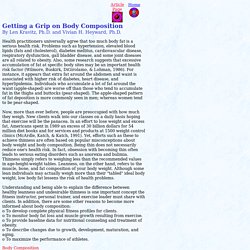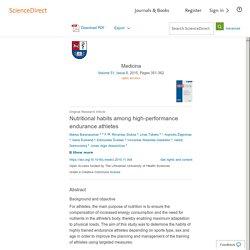

Differences Between Fat Free Mass & Lean Body Mass. The terms "lean body mass" and "fat-free mass" are used to describe body composition.

Although they may be used interchangeably, they are not the same. Lean body mass includes fat that acts as fuel for energy production and other processes that are part of normal metabolism. On the other hand, fat-free mass does not include any fat. This video file cannot be played. (Error Code: 102630) Understanding Body Composition. Getting a Grip on Body Composition By Len Kravitz, Ph.D. and Vivian H.

Heyward, Ph.D. Health practitioners universally agree that too much body fat is a serious health risk. Problems such as hypertension, elevated blood lipids (fats and cholesterol), diabetes mellitus, cardiovascular disease, respiratory dysfunction, gall bladder disease, and some joint diseases are all related to obesity. Also, some research suggests that excessive accumulation of fat at specific body sites may be an important health risk factor (Wilmore, Buskirk, DiGirolamo, & Lohman, 1986).
For instance, it appears that extra fat around the abdomen and waist is associated with higher risk of diabetes, heart disease, and hyperlipidemia. Now, more than ever before, people are preoccupied with how much they weigh. Metabolism. Two processes of metabolism Metabolism refers to all the chemical processes going on continuously inside your body that allow life and normal functioning (maintaining normal functioning in the body is called homeostasis).

These processes include those that break down nutrients from our food, and those that build and repair our body. Building and repairing the body requires energy that ultimately comes from your food. The amount of energy, measured in kilojoules (kJ), that your body burns at any given time is affected by your metabolism. If we eat and drink more kilojoules than we need for our metabolism and exercise, we store it mostly as fat. Two processes of metabolism Your metabolism has two parts, which are carefully regulated by the body to make sure they remain in balance. Metabolic rate. Bupa.com. Total daily energy expenditure. To maintain a healthy body weight, you need to match food intake to energy expenditure, but you also need to be physically active and metabolically flexible!
Sedentary behavior is a risk factor for metabolic disease.

Contemporary societies have largely engineered physical activity out of daily life to the point that physical inactivity is now the 2nd leading cause of death in the U.S. and the 4th worldwide. This represents about 5.3 million deaths per year, which is equivalent to the 5 million deaths attributed to tobacco usage. This latter statistic has led to a media campaign targeting the catch phrase “Sitting is the new smoking!”.
Indeed, it has become evident that sedentary behaviors (e.g. sitting) play an independent and critical role in the development of metabolic diseases, such as obesity and type 2 diabetes. Maintaining body weight requires that energy intake matches energy expenditure. To maintain a stable body weight, energy intake needs to be equal to energy expenditure. Maintaining body weight requires that the amount of carbohydrate, fat, and protein you ingest matches the amount burned. Why is all of this important? References. 57 1332917760. Sport Performance and Body Composition.
International journal of womens health and wellness ijwhw 2 041. Evaluation of Dietary Intakes, Body Composition, and Cardiometabolic Parameters in Adolescent Team Sports Elite Athletes: A Cross-sectional Study. How to Improve Body Composition, Based on Science. MJSSM September 2017 Nepocatych 57 65. Nutritional habits among high-performance endurance athletes. JavaScript is disabled on your browser.

Please enable JavaScript to use all the features on this page. Open Access funded by The Lithuanian University of Health Sciences Abstract Background and objective For athletes, the main purpose of nutrition is to ensure the compensation of increased energy consumption and the need for nutrients in the athlete's body, thereby enabling maximum adaptation to physical loads. Materials and methods In 2009–2012, the dietary habits of 146 endurance athletes were analyzed. Results It was found that 80.8% of endurance athletes used lower-than-recommended amounts of carbohydrates in their diet, and more than 70% of athletes used higher-than-recommended levels of fat, saturated fatty acids, and cholesterol. Conclusions The diet of highly trained endurance athletes does not fully meet their requirements and in this situation cannot ensure maximum adaptation to very intense and/or long-duration physical loads.
Keywords Nutritional habits High-performance.